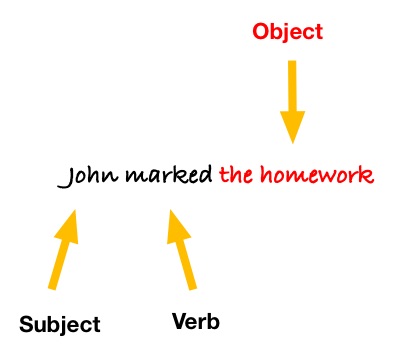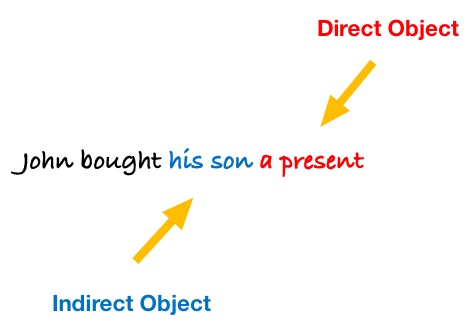- Home
- Parts of a Sentence
- Direct and Indirect Objects
Direct and Indirect Objects
Direct and indirect objects are key parts of building sentences that you should understand. Here we will look at the key difference between them.
Objects
Objects in sentences refer to someone or something in relation to the subject’s action of the verb. They come after the verb (and any words or phrases that modify the verb). So the pattern is Subject + Verb + Object.

There are two types of objects in English grammar, direct and indirect objects.
Direct Objects
The example above is an example of a direct object. A direct object is the receiver of the action within a sentence and it answers the question "who?" or "what?".
John marked the homework
(What did John mark? = the homework)
Alice hit Susan
(Who did Alice hit? = Susan)
So in the first case, the action (the verb) is the marking and it is the homework that is receiving this action i.e. it is being marked. In the second case, the receiver of the action - the hitting (verb) - is Susan, so Susan is the direct object.
Indirect Objects
In order to have an indirect object in a sentence, there must be a direct object.
The indirect object is the recipient of the direct object. Or in other words, it identifies to or for whom or what the action of the verb is performed.
The direct object and indirect object will be different people, places or things.

Subject + Verb + indirect Object + direct object
John bought his son a present
(For whom did John buy a present? = his son)
The office staff gave Phillip a card
(To whom did the staff give a card? = Philliip)
So in the first case, the son is the recipient of the direct object (the present). So the action - buying the present - is being performed for him. In the second case the recipient is Phillip, who is the recipient of the card (direct object).
Examples of Direct and Indirect Objects
Here are some example sentences. All the direct objects are in bold. Where an indirect object is included in the second set of examples, the indirect object is in italics.
Sentences with Direct Objects
- Steve turned on the TV
- The car hit the pedestrian
- Billy stroked the hamster
- Sheila spoke to her neighbour
- Mike started the argument
Sentences with Indirect and Indirect Objects
- John passed Tim the book
- Let her take it
- Anne gave Ian a strange look
- My brother bought me a bike
- The mother read her child a story
Now try this direct and indirect objects quiz >>>
New! Comments
Any questions or comments about the grammar discussed on this page?
Post your comment here.


